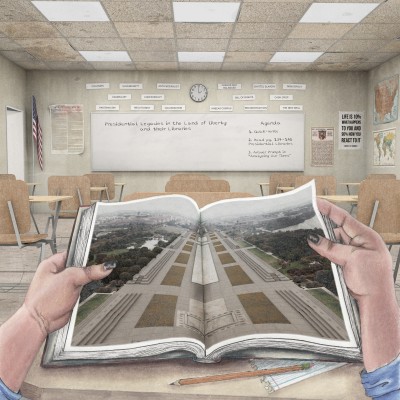Roll Call is the story of Mia, an 11th-grade girl attending a US history class designated for English learners. One morning, the class arrived at a lesson titled: “Presidential Legacies in the Land of Liberty and their Libraries.” As her teacher began to take roll, Mia opened her book and began scrolling through photos of the various presidential libraries. At first glance, the libraries appeared to hold important documents, books, and cultural artifacts commemorating a president’s legacy. She continued to flip through the textbook, settling on another chapter showcasing the monuments of the National Mall and Memorial Park in Washington D.C. While admiring the grandiose structures meant to memorialize the country’s heroes--men like Washington, Jefferson, and Lincoln--Mia began to question the role these structures play in constructing a national memory. When did the country's story begin? And with who? Quietly taking out her phone, Mia discovered that the Nacotchtank peoples were the original caretakers of the land now claimed as the nation’s capital. She looked at the Washington Monument. To some, George Washington was the father of a nation. However, to others, he was a slave master who had gained fame as a soldier helping wage a genocidal war against indigenous peoples. “Has this war ever ended?” she asked herself. Mia thought of the atrocities of colonialism--things like the settler conquest, exploitation, and dehumanization--and how they continued into the present. She looked up and stared at two empty seats at the front of the classroom. They had once belonged to two friends whose family had been deported from the United States. They were gone, back to Haiti and Mexico, without a trace, no monument to commemorate their existence.
She looked back down to the photo of the National Mall and began to reimagine the architecture and landscape for a presidential library. The image caption would say:
The National Library, founded in 2020, was created after the people demanded that the 45th president’s racist and prejudiced term come to an end. The people believed it was time to commemorate and document an era of truths that told multiple histories and experiences of people who were dispossessed and forcibly removed from the land. The National Library now sits on The National Mall and Memorial Park as it encapsulates the ruins of the Lincoln Memorial and Washington Monument. It acts as a symbol of the fall of these monuments that revere a racist social structure built on the oppression of people of color. The library no longer aspires to only preserve the legacy of presidents; instead, it focuses on factual experiences of people and the documentation of history for a diverse society. The landscape becomes an homage to a society that was built by enslaved people and those who have been erased. Essentially, the National Mall and Memorial Park were repurposed as an open library where other sides of history are exposed.
Mia’s teacher called her name and she responded “presente.” Her teacher paused. As he prepared to remind her that in his class they were practicing English, Mia asked:
“Why do we learn about a history of people who enslave us and remove us and not about the history of the people who were in our class?”
